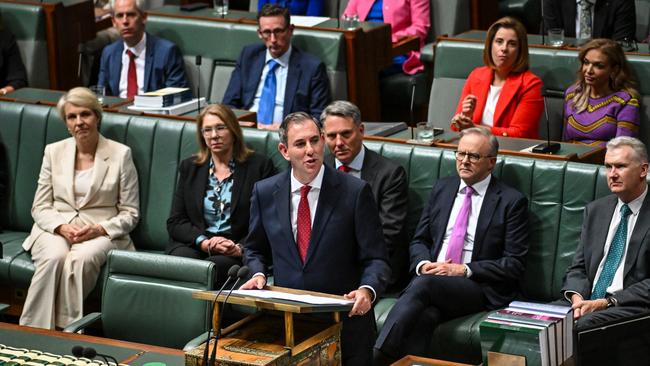$23bn Future Made in Australia policy’s big-ticket items start in 2027-28, beyond the scope of budget papers
Labor has earmarked $23bn to help create a “renewable energy superpower”, but most of the support only starts to flow in 2027-28. While the policy may play politically, it makes little economic sense, experts say.
NSW
Don't miss out on the headlines from NSW. Followed categories will be added to My News.
For the first time, it is clear why Labor’s strategy to revive manufacturing is called the “Future Made in Australia” policy – the big-ticket items don’t start for another four financial years.
Anthony Albanese named the policy prior to the 2022 election campaign – when he declared “serious countries should make things”.
But 24 months later, there is still the distinct impression that it is very much a work in progress.
The budget reveals the future begins in 2027-28.
Nearly $23 billion worth of tax incentives and cash will be delivered from then until 2039-40, spent on “backing Australian ideas” that either help make the nation a “renewable energy superpower” or “strengthen economic security”.
While the numbers are big, there is scant detail, with the government admitting the two most expensive elements of its vision, related to green hydrogen and critical minerals, are “subject to consultation”.

Meanwhile nearly $1 billion already announced towards one day making local solar panels is in a “contingency reserve pending consultation and design.”
Much of the plan is so far away it doesn’t even show up in the official budget papers.
The government described a $6.7 billion tax incentive for renewable hydrogen produced between 2027 and 2040 as its “flagship” decision.
In a bid to ensure there are sufficient takers for the incentive, $1.3 billion will be spent over the next decade to help hydrogen’s “early movers”.
Labor is betting Australia can become a global leader in the clean fuel, arguing “our world-class renewable energy resources” mean we can compete on price.
“Additionally, Australia is close to key markets,” it said, without saying what those were.
Creating a hydrogen industry “opens the door to green metals such as iron, steel, alumina and aluminium,” the government said, which can be used to make “wind turbines, electric vehicles and grid infrastructure.”
Another $7 billion tax incentive for producing 31 critical minerals was foreshadowed, again payable from 2027-28 to 2039-40, rebating 10 per cent of processing and refining costs.
For the world to hit net zero by 2050, “demand for critical minerals is expected to increase by around 350 per cent by 2040,” the government said.
“Australia is in a strong position to supply these minerals, with some of the world’s largest reserves in lithium, cobalt and rare earths.”
Details of both the green hydrogen and critical minerals “programs are subject to consultation,” the government said.

Treasury officials told The Daily Telegraph the cost to the budget of the two programs over the four years of the official budget papers was $500m, entirely in 2027-28.
Some experts are critical of the government’s Australian-made plan, saying that while it may work politically, it makes little to no economic sense.
“I think this Future Made in Australia (policy) is part manufacturing fetishism and partly about winning seats in Western Australia, Queensland and to some extent, the (NSW) Hunter Valley,” independent economist Saul Eslake told The Daily Telegraph prior to the budget’s release.
Mr Eslake said “manufacturing fetishists” think manufacturing jobs are better than work in construction or agriculture.
“Most of us don’t want our kids to work in a factory,” Mr Eslake said.
“But a lot of people seem to think other people’s kids should be working in factories.”
Do you have a story for The Daily Telegraph? Message 0481 056 618 or email tips@dailytelegraph.com.au
Originally published as $23bn Future Made in Australia policy’s big-ticket items start in 2027-28, beyond the scope of budget papers



